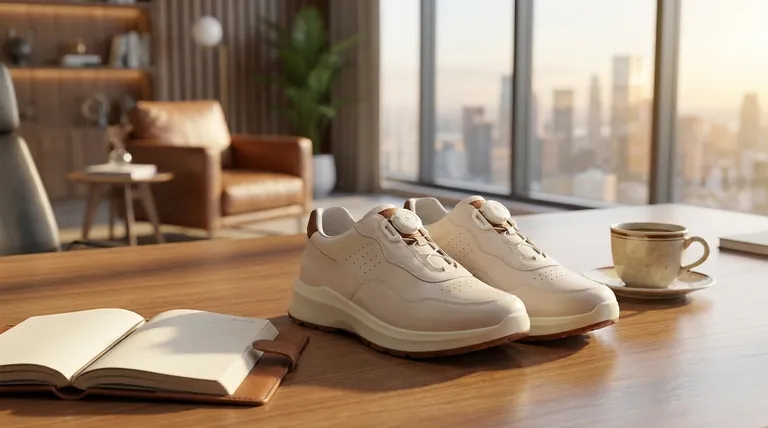The modern concept of casual shoes began its rise to popularity in the post-World War II era, after 1945. This period introduced more affordable manufacturing and new styles that laid the groundwork for major booms in the 1970s and a subsequent explosion of diverse styles in the 1990s and 2000s.
The popularization of casual shoes was not a single event but a gradual cultural shift. It was driven by post-war prosperity, the rise of youth culture, and manufacturing innovations that made comfort and self-expression accessible to everyone.

The Foundation: Post-War Shifts (After 1945)
The end of the war marked a turning point, creating the social and economic conditions necessary for a move away from purely formal or utilitarian footwear.
A New Definition of Leisure
With the war over, many Western societies experienced economic growth and the expansion of the middle class. This led to an increase in leisure time, creating a new demand for comfortable, informal clothing and shoes suitable for activities outside of work or formal events.
Manufacturing Innovations
New, more affordable manufacturing techniques and materials became widespread. This shift made a wider variety of shoe styles accessible to the average person, moving beyond the traditional, often expensive, leather footwear that had previously dominated.
The Rise of Counter-Culture (1970s)
While the seeds were planted after the war, the 1970s was the decade where casual footwear truly became a powerful tool for self-expression and group identity.
The Sneaker and Boot Explosion
The 1970s saw the introduction and popularization of iconic styles like sneakers and high-top trainers. This was a significant departure from the simple canvas shoes of previous decades.
Styles as Identity
Simultaneously, subcultures adopted specific footwear as a uniform. The rise of Doc Martens and lace-up combat boots in punk and rock scenes cemented the idea that your shoes could make a statement about your identity and beliefs.
From Niche to Mainstream (1990s - 2000s)
The end of the 20th century saw casual shoes complete their journey from the fringe to the absolute center of global fashion and daily life.
The Influence of Subcultures
The 1990s and early 2000s witnessed an explosion of popular styles driven by music and sports. Hip-hop culture elevated brands like Nike and Adidas to iconic status, while skateboarding did the same for skate shoes, turning niche footwear into mainstream must-haves.
The "Business Casual" Revolution
Perhaps the most significant shift was the adoption of "business casual" dress codes in many offices. This officially broke down the final barrier, allowing casual shoes to move from the street and the weekend into the professional world, solidifying their place as the default footwear for millions.
Understanding the Trade-offs
The dominance of casual footwear was a revolutionary shift in how we dress, but it came with inherent trade-offs compared to the era of traditional shoemaking.
Durability vs. Affordability
Traditional leather shoes were often built to be repaired and resoled, lasting for many years. Many modern casual shoes, while more affordable upfront, are often manufactured with fused soles and synthetic materials that are difficult or impossible to repair, leading to a faster replacement cycle.
The Blurring of Formality
The universal adoption of casual footwear offers immense comfort and flexibility. However, it has also eroded traditional dress codes, which can sometimes create ambiguity or confusion about what is appropriate for certain occasions.
How This History Shapes Footwear Today
Understanding this evolution helps contextualize the footwear landscape we see around us every day.
- If your primary focus is historical context: Recognize that the shift began after 1945, driven by new manufacturing capabilities and a cultural desire for leisure and comfort.
- If your primary focus is cultural trends: Pinpoint the 1970s and 1990s as the key decades when music and youth subcultures turned specific shoe styles into global phenomena.
- If your primary focus is modern fashion: Understand that today's "sneaker culture" is the direct result of this decades-long evolution, blending comfort, technology, and personal identity.
Ultimately, your shoes are a direct link to the major social and technological transformations of the last century.
Summary Table:
| Era | Key Developments | Popular Styles |
|---|---|---|
| Post-WWII (After 1945) | Economic growth, leisure time, affordable manufacturing | Simple canvas shoes, loafers |
| 1970s | Rise of youth culture, self-expression | Sneakers, high-top trainers, Doc Martens boots |
| 1990s-2000s | Influence of music/sports, business casual dress codes | Athletic sneakers, skate shoes |
Ready to Source the Next Generation of Casual Footwear?
As a large-scale manufacturer, 3515 produces a comprehensive range of footwear for distributors, brand owners, and bulk clients. Our production capabilities encompass all types of shoes and boots, from classic casual styles to modern athletic-inspired designs. We combine historical manufacturing expertise with contemporary trends to deliver quality, comfort, and style.
Partner with us to:
- Access a diverse catalog inspired by decades of footwear evolution.
- Benefit from reliable, large-scale production for your brand or retail needs.
- Offer your customers the comfort and style that define modern casual wear.
Contact 3515 today to discuss your manufacturing needs and bring quality footwear to your market!
Visual Guide

Related Products
- Wholesale Smart Casual Sneakers with Dial Closure | Factory Direct Manufacturing
- Wholesale Leather Business Casual Shoes with Dial Closure - Manufacturer of Comfort Dress Sneakers
- Wholesale Comfortable Business Casual Shoes Custom Manufacturing
- Premium KPU Athletic Safety Shoes for Wholesale
- Durable Rubber-Soled Utility Shoes for Wholesale & Custom Brand Manufacturing
People Also Ask
- What factors should men consider when choosing casual shoes? A Guide to Comfort, Style & Durability
- Why are sneakers now accepted in office environments? The Shift to Modern Professionalism
- Are dress sneakers appropriate for business casual? How to Wear Them Professionally
- What steps can be taken to ensure the best selection of casual sneakers? A Guide to Comfort, Style & Durability
- What are the key features to look for in comfortable office work shoes? Find Supportive & Ergonomic Footwear



















